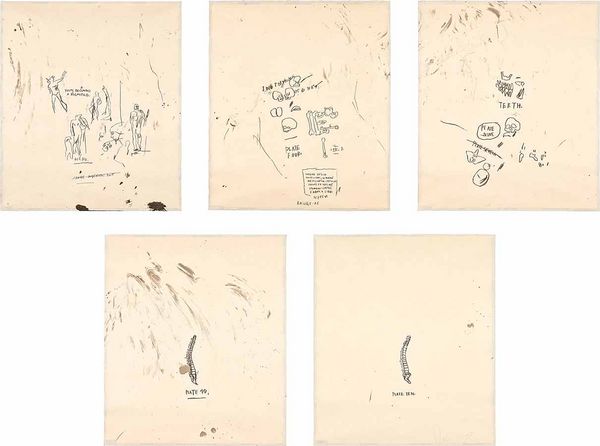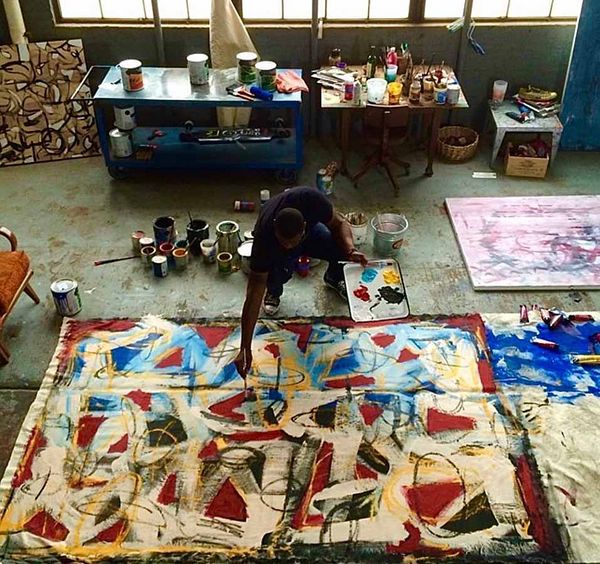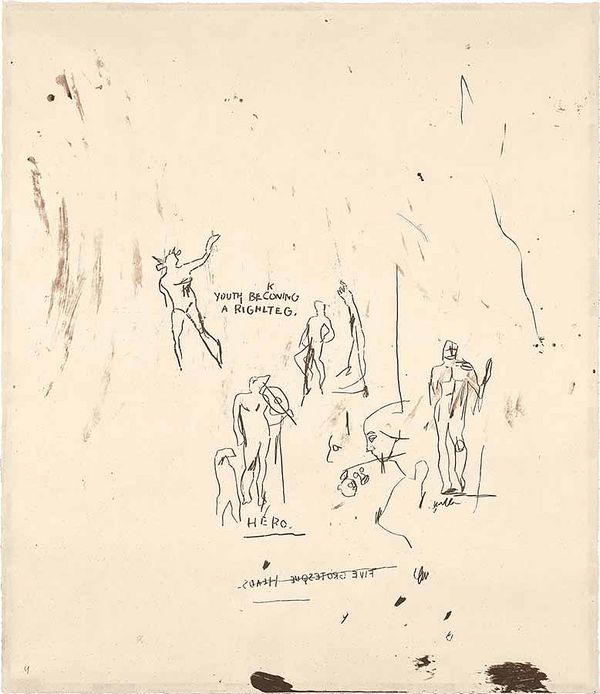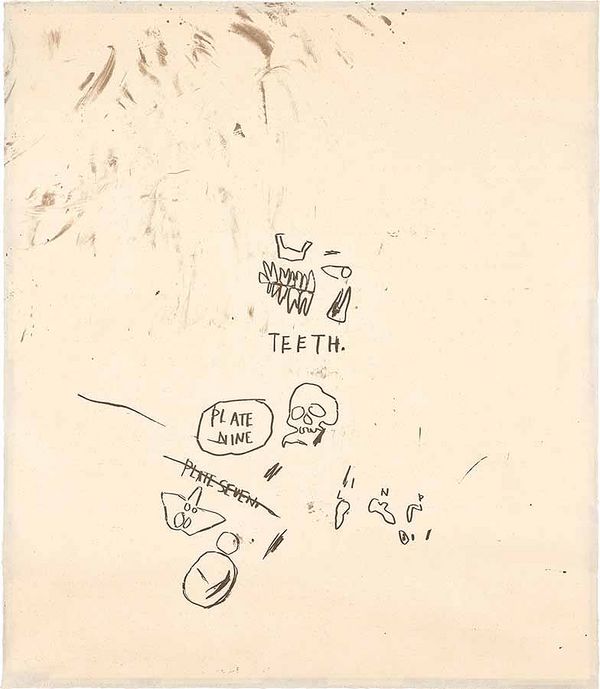Jean-Michel Basquiat, Untitled (from Leonardo), 1983. Editions & Works on Paper, New York.
Coming to Phillips from the collection of former professional basketball player and contemporary artist Desmond Mason, Jean-Michel Basquiat’s Untitled (from Leonardo) serves as a captivating reflection on the high Renaissance anatomical studies of Leonardo da Vinci and is notably one of the few prints the artist produced during his lifetime. Basquiat’s influence and inspiration run deep for Desmond Mason, whose own practice draws upon a lifetime of overcoming the odds and showing how art happens before and after the court. Our New York Editions team caught up with the artist-athlete to talk Basquiat, collecting, and why artist comes first in his title.
CARY LEIBOWITZ, Worldwide Co-Head of Editions and Department Chairman, Americas: We caught you at a busy time, haven’t we?
DESMOND MASON: Busy, busy – I’m in the middle of three exhibitions right now. I’m finally back at home for a bit, but we’re going out to Vegas, and then Art Basel in Miami, and we’re preparing for all of it at the same time. Then back-to-back Mexico City and Tulum for early 2025. Oh, and Seattle in August; that’ll be my year. I have about twelve commissions going on right now, too.
CL: A lot of wet paint!
DM: And it’s over the place. But I don’t use fuchsia, and I don’t use brown.
CL: Tell us a bit about some of your early influences.
DM: I grew up in a very small town south of Dallas; my dad was probably the biggest drug dealer for a hundred-mile stretch of I-35 between Dallas and Waco; we literally had a railroad track that divided the Black and white sides of town. Because my dad was who he was, I was able to go back and forth easily between those sides. When my dad went to prison, I lived with my best friend for a bit on the other side of the tracks n, and that was an eye-opening experience. This was the mid 1980s, when everyone was dressing like punks and Guns N’ Roses and skateboarding, and a classmate named Rusty Fuller was just this incredible artist. He tagged walls and drew on skateboards for people – I credit him with getting me into art. We all would tag together and at that point all I wanted to do was be better at drawing than Rusty. I was drawing on book covers, desks, anything really, and I fell in love with it.
Desmond Mason in his studio.
CL: And you ended up going to school for it. You’ve also mentioned your background with Abstract Expressionist painters.
DM: I was studying to be an art teacher. I was into hyper realism at first because this was back when I was first getting into it and guys like Rusty were doing skulls and trucks and Nike shoes, so I went in that direction. I’ll never forget when I was in studio art and my teacher lit a balled-up piece of paper and put it on a pedestal for us to draw. It was the hardest thing I ever had to draw! The shading was just crazy to me.
I remember watching the movie Pollock after getting drafted into the NBA. I went out and bought twenty feet of canvas and rolled it out in my backyard with whole gallons of paint and started doing that style of painting. From there I transitioned from pure realism to figurative, and then more and more abstract. This was around 2001.
CL: How did you first get into collecting?
DM: I was only 22, but the first work I ever bought was a Picasso. We were in LA and while my teammates were buying jewelry and cars, I went to Martin Lawrence Gallery. The car dealerships were used to basketball players walking in, but probably not the galleries from the looks I got. I mean, I was wearing my team sweatpants. I asked about the price of a Warhol and the guy said it was “upon request.” So I said, well, I’m requesting! We start looking around more, and we come upon this Picasso etching that just looks incredible. I was on the phone with my financial advisor and finally I’m like this is it, I’ll take it. The guy asks me where he should send it and I tell him to wrap it up right there; I’m taking it with me. We played the Lakers that night and I had the team equipment manager keep an eye on it while I played and then I flew back to Seattle with it on my lap.
I bought the Basquiat pieces after my daughter was born. That was the main reason for getting them: for her to have something to hold onto and decide what she wants to do with them with the time comes. If I could sway her, I’d keep them forever.
Jean-Michel Basquiat, Untitled (from Leonardo) [Youth Beckoning a Right Leg detail], 1983. Editions & Works on Paper, New York.
KELLY TROESTER, Worldwide Co-Head of Editions and Deputy Chairwoman, Americas: We saw a few of your etchings as well; they’re a much different approach than your paintings – were you doing prints before you collected the Basquiat works, or did they help push you in the direction of printmaking?
DM: I took three years of etching in college, from sophomore year. Around 2003-4, I started doing copper plate etching again, so I was back to doing single line works and ended up doing them for four years. During that time, I was traded from Seattle to Milwaukee, and then Milwaukee to Oklahoma City, then back to Milwaukee, and then back to Oklahoma City again. By 2010, I opened my own gallery mostly to house my own works – I did an opening that featured a lot of those etchings. I made five copies of each and then destroyed the plates. I think I made 25 over a five-year frame.
KT: It’s amazing to see how that line turns out so much differently after it’s printed.
DM: It was daunting! I ended up destroying the first plates, even if that was hard to do. [FF2] If I didn’t like something, I would just trash them. Then I started painting over old paintings and anything I didn’t like or plan to show. The textures from the old piece became the body of the new one.
CL: How then did Basquiat come into your practice?
DM: It came through music since everyone was name-dropping him; Jay-Z especially. Between 1996 and 2000, when I was in college, no one was studying him in studio art. He wasn’t on the radar in a formal way. My wife would tell you that when I get locked into an idea, or I’m working nonstop and find myself doing a million things at once, I’ll watch the movie Basquiat – I’ve probably seen it fifty times. I started seeing parallels between him and my studies of Pollock and took it from there.
Jean-Michel Basquiat, Untitled (from Leonardo) [Plate Four detail], 1983. Editions & Works on Paper, New York.
CL: I think he would be inspired by your own story.
DM: His era, his time being an artist in New York and becoming part of that scene with all of its ups and downs and personal battles – even if it’s not a direct comparison, a lot of it resonates with me. I was fortunate enough to have long professional career and I’ve always wanted to help my family and the people around me, but a lot can and does backfire. People you love and trust see you as an ATM; there’s a lot of his story I feel sad for, but his work goes beyond his life.
CL: Are your personal paintings in a way reflecting on those influences and similarities?
DM: From the beginning, my influences have never really changed all that much. I draw inspiration from my past, my present, where I see myself, my family, and my travels. Every year, really every year, I do what I call a “bow” to my favorite artists and create a body of work in their style, but with my story. I don’t do it to mimic them; it’s really just for me. I call it painting for me.
Desmond Mason, CABO, mixed media on wood panel, 2019.
CL: You see some parallels with these works in particular: Basquiat is “bowing” to Leonardo – did that inspire your idea of borrowing from your own heroes?
DM: Absolutely. The Leonardo example is basically studying the book. It’s one of those things where I discover an influence through another one. Basquiat was extremely smart with his references.
CL: This might be a ridiculous question, but we have to ask: is there any connection to you between dunking and painting?
DM: [Laughs] Honestly it’s not ridiculous. I have to give a little background here: when I was in college, we weren’t allowed to have jobs outside of our scholarships or take payment for anything. I was putting my mother through a rehab facility around the time Sports Illustrated ran an article about me and my drawing, and someone who read the piece reached out to buy one of the works. I didn’t want to get in trouble, so I asked my coach and he called the NCAA to get it all cleared. They called us back and said no. My first sale fell through because of that!
Once I got drafted, David Stern, the NBA commissioner, called me into his office in New York and I showed him a charcoal drawing of Al Pacino in Heat and he bought it. That makes David Stern the first person to buy a work of mine; that’s a direct connection between my art and the game. But to answer your question, everything I did in basketball – from dunking to moving around the court – was about art and improvising. There’s so much that goes into the creative side of the game. There’s graphic work, choreography, apparel design, arena architecture, music, everything; an NBA game is surrounded by art, and art touches every aspect of the game.
KT: You feature a lot of public art and installations on your page. Are you working on any community-based projects at the moment?
DM: Yeah, absolutely. So many people have supported me and my journey, and I want to give back for it. I give back a portion of my sales to the city or town where it goes. I research the places where I sell; what the people in that place need, and what I can do to support them the way they’ve supported me. It a mutual sense of community.
Jean-Michel Basquiat, Untitled (from Leonardo) [Plate Nine detail], 1983. Editions & Works on Paper, New York.
KT: Anything else we should know about your upcoming projects?
DM: Right now I’m in the middle of a memoir and a project with Antoine Fuqua, who you might remember from Training Day and a bunch of other Denzel Washington movies. He heard my story through a collector, and he also played basketball, so there was a connection there. He wants to see which parts of the book speak to people the most to get the best out of a script. I’m going through my memories and thinking about my experiences as other people might see them, you know? When I was three, I had third-degree burns on over 60% of my body and spent over six months in the hospital – they said even if I could walk again, I’d definitely never run. I was playing sports again by the time I was five, and the idea of proving them wrong always sits with me. I’ve been fortunate in a sense to be underestimated or mistaken. I’m an artist who gets mistaken for an athlete. That’s the story we want to tell.
KT: There’s much more longevity in art than in our professions.
DM: I agree fully. People ask me if I miss basketball or say that I retired from basketball and then decided to paint – I always joke that basketball got in the way of painting for ten years. I tell them I get to paint six days a week and spend time with my kids. Shaq can’t elbow me in the face in my studio!
[Laughter]
Auction Information
New York Auction 16 - 17 April





